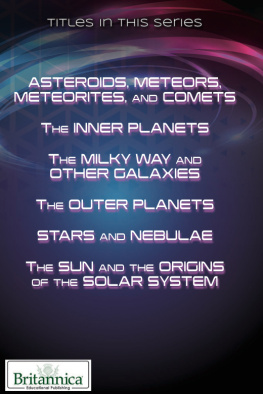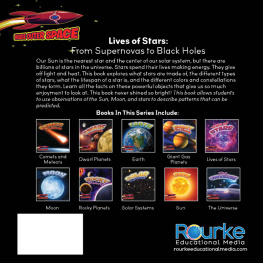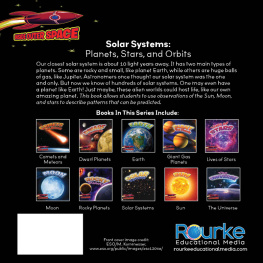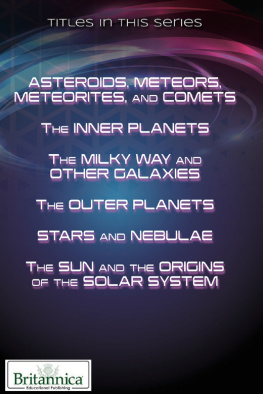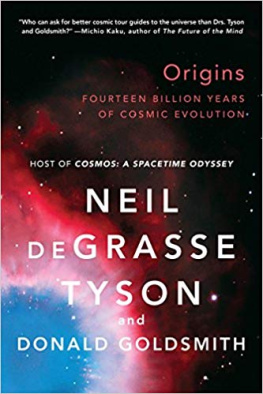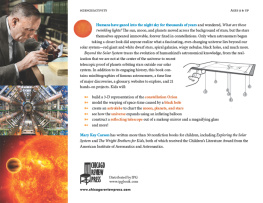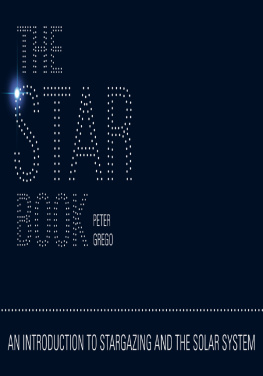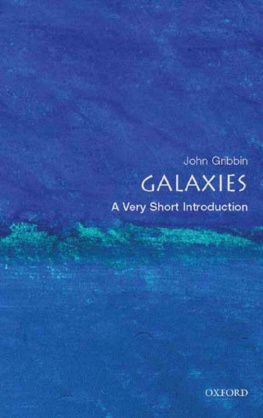THE SUN, STARS, AND GALAXIES
the solar system
THE SUN, STARS, AND GALAXIES
Edited by Michael Anderson

Published in 2012 by Britannica Educational Publishing
(a trademark of Encyclopdia Britannica, Inc.)
in association with Rosen Educational Services, LLC
29 East 21st Street, New York, NY 10010.
Copyright 2012 Encyclopdia Britannica, Inc. Britannica, Encyclopdia Britannica, and the
Thistle logo are registered trademarks of Encyclopdia Britannica, Inc. All rights reserved.
Rosen Educational Services materials copyright 2012 Rosen Educational Services, LLC.
All rights reserved.
Distributed exclusively by Rosen Educational Services.
For a listing of additional Britannica Educational Publishing titles, call toll free (800) 237-9932.
First Edition
Britannica Educational Publishing
Michael I. Levy: Executive Editor, Encyclopdia Britannica
J.E. Luebering: Director, Core Reference Group, Encyclopdia Britannica
Adam Augustyn: Assistant Manager, Encyclopdia Britannica
Anthony L. Green: Editor, Comptons by Britannica
Michael Anderson: Senior Editor, Comptons by Britannica
Sherman Hollar: Associate Editor, Comptons by Britannica
Marilyn L. Barton: Senior Coordinator, Production Control
Steven Bosco: Director, Editorial Technologies
Lisa S. Braucher: Senior Producer and Data Editor
Yvette Charboneau: Senior Copy Editor
Kathy Nakamura: Manager, Media Acquisition
Rosen Educational Services
Jeanne Nagle: Senior Editor
Nelson S: Art Director
Cindy Reiman: Photography Manager
Matthew Cauli: Designer, Cover Design
Introduction by Jeanne Nagle
Library of Congress Cataloging-in-Publication Data
The sun, stars, and galaxies / edited by Michael Anderson.1st ed.
p. cm.(The solar system)
In association with Britannica Educational Publishing, Rosen Educational Services.
Includes bibliographical references and index.
ISBN 978-1-61530-568-1 (eBook)
1. SunJuvenile literature. 2. StarsJuvenile literature. 3. GalaxiesJuvenile literature. I.
Anderson, Michael.
QB521.5.S87 2012
523dc22
2011002628
Cover, back cover Shutterstock.com; pp. www.istockphoto.com/Brandon Alms; pp.21, 30, 31, 42, 45, 46, 65, 66, 74, 79 www.istockphoto.com/Sergii Tsololo; remaining interior background image www.istockphoto.com/ Amanda Rohde
CONTENTS







introduction

T winkle, twinkle, little star
How I wonder what you are
Readers of this book will wonder no more. In these pages lies information on the properties and characteristics of stars, including one star that is vital to life on Earth, the Sun. Topics include star composition, brightness, and configuration into constellations; the layers of the Sun and its role as the center of the solar system; and the shape of and energy emitted by large groups of stars known as galaxies. The scientific exploration of these illuminated celestial bodies through the years is also covered.
Up above the world so high
Like a diamond in the sky
The common image of stars as tiny points of light softly twinkling in the night sky belies their truly awesome power. Even their births are intense. Stars are formed when gravity forces a cloud of dust and debris to contract, causing a violent collision of hydrogen atoms. This high level of intensity carries through the life of a star as its core, or nucleus, burns courtesy of continuous explosions that are like nuclear bombs detonating. Eventually all the fuel in the core gets used up, and many stars simply collapse in upon themselves. This process leaves a small core that will eventually burn itself out as it cools. Some stars, however, go out in spectacular fashion as supernovas, exploding into vast fields of debris that eventually contribute to the creation of new stars.
In the vast scheme of the universe, the Sun is a pretty average star. It is estimated to be nearly 5 billion years old, which means it still has billions of years to shine before it reaches the end of its life cycle. Size-wise, the Sun falls somewhere in the middle between massive giants and tiny dwarfs. Within the solar system, however, the Sun is anything but average. Here, it is the center of all the action. A full 99 percent of the solar systems mass is taken up by the Sun. (Eight planets and their satellites, the dwarf planets, and an assortment of meteors, asteroids, and other celestial bodies account for the remaining 1 percent.) Although it is roughly the same size as billions of other stars, the Sun appears larger because it is relatively close (93 million miles/150 million kilometers) to Earth.
At the center of the Sun is the core, an extremely dense, pressure-filled collection of atomic particles. Heat and light are emitted from the photosphere, which is the Suns surface layer. The photosphere is in constant motion due to rolling solar waves. Another characteristic of the photosphere is sunspots, which are cooler dark patches caused by strong magnetic activity. Higher levels of the Suns atmosphere are the chromosphere and the corona, which are not as visible as the photosphere but are actually much hotter.

Stephans Quintet, a group of galaxies with stars of many ages and colors, as seen from the Hubble Space Telescope. NASA, ESA, and the Hubble SM4 ERO Team
Planets orbit the Sun, but the Sun has an orbit of its own, around the center of the Milky Way galaxy. The Milky Way is just one of many of these enormous collections of stars that make up the universe. A galaxy consists of millions or even hundreds of billions of stars in any of a variety of shapes: elliptical, spiral, barred spiral, or irregular (which seem kind of formless). The Milky Way is a spiral galaxy.
Twinkle, twinkle, little star
Now I know just what you are
chapter 1
THE SUN: THE CENTER OF THE SOLAR SYSTEM

A lthough the Sun is a rather ordinary star, it is very important to the inhabitants of Earth. The Sun is the source of virtually all Earths energy. It provides the heat and light that make life on Earth possible. Yet Earth receives only about half a billionth of the energy that leaves the Sun.
Next page







